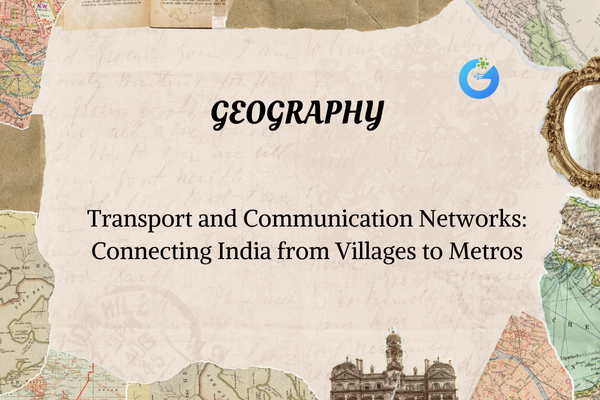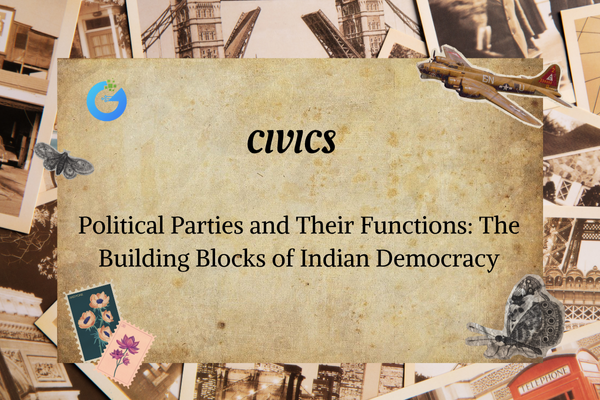Introduction: The Pulse of a Moving Nation
Imagine if trains stopped running for a week, roads were closed, flights got cancelled, and internet connections were cut off. What would happen? Markets would be empty, people couldn’t reach offices, students couldn’t attend classes, and families wouldn’t stay connected.
Transport and communication are like the nerves of a country. They connect cities, towns, and villages. They also carry not just goods and people—but ideas, information, and culture.
In a country as big and diverse as India, these systems play a crucial role in national unity and development.
expert-led Geography classes – visit our website to learn more
What Is Transport?
Transport refers to the physical movement of goods and people from one place to another. It makes travel possible, connects regions, and helps the economy grow.
India has four major types of transport:
| Type | Use Case |
| Roadways | Everyday travel, short to medium distances |
| Railways | Long-distance and heavy goods |
| Waterways | Cheapest for bulk goods and heavy cargo |
| Airways | Fastest for passengers and express cargo |
Roadways: India’s Everyday Network
Road transport is the most widely used form of transport in India.
Key Features:
- Roads can be built in all kinds of terrains—plains, hills, deserts.
- Ideal for short trips and door-to-door delivery.
- Connect rural villages to nearby towns.
Types of Roads:
| Type | Details |
| National Highways | Connect major cities and states (e.g., NH44 from Kashmir to Kanyakumari) |
| State Highways | Link state capitals to district headquarters |
| District & Rural Roads | Built under schemes like PM Gram Sadak Yojana to connect villages |
Railways: India’s Moving Lifeline
India has one of the largest railway networks in the world. From bustling metros to remote villages, trains are everywhere.
Why Railways Matter:
- Economical for long distances.
- Used for both passengers and cargo.
- Helps move coal, food, cement, and other goods.
Special Trains:
- Rajdhani Express: High-speed trains connecting state capitals to Delhi.
- Shatabdi Express: Fast intercity travel.
- Vande Bharat: India’s first semi-high-speed electric train.
Waterways: Moving Heavy Goods Cheaply
Water transport is cost-effective and eco-friendly, especially for bulky items.
Types of Waterways:
| Type | Examples |
| Inland Waterways | Ganga, Brahmaputra rivers |
| Coastal Shipping | Sea routes along India’s coastlines |
Major Ports:
| Port | State |
| Mumbai | Maharashtra |
| Kolkata | West Bengal |
| Chennai | Tamil Nadu |
| Kochi | Kerala |
India is working to modernize its ports under the Sagarmala Project to boost trade.
Airways: Fast and Efficient
Airways are the fastest mode of transport, essential for long distances and urgent needs.
Features:
- Ideal for perishable goods, organ transport, or emergencies.
- Connects far-off areas like the Andaman Islands or the Northeast.
Major Airports:
| Airport | City |
| Indira Gandhi International Airport | Delhi |
| Chhatrapati Shivaji Maharaj Airport | Mumbai |
| Kempegowda International Airport | Bengaluru |
| Rajiv Gandhi International Airport | Hyderabad |
Government Scheme: UDAN
UDAN (Ude Desh Ka Aam Nagrik) makes flying affordable and promotes regional air connectivity.
What Is Communication?
Communication is the process of sending or receiving messages, information, or ideas between people. It keeps individuals and society connected.
Two Main Types:
- Personal Communication: One-on-one (e.g., phone calls, letters)
- Mass Communication: Reaches a large audience (e.g., TV, radio, internet)
Types of Communication Media
| Type | Examples |
| Print Media | Newspapers, books, magazines |
| Electronic Media | Television, radio |
| Digital Media | Mobile phones, internet, social media |
| Postal Services | Letters, parcels, couriers |
Important National Services:
- Doordarshan: National television service.
- All India Radio (AIR): National radio broadcasting.
- India Post: World’s largest postal network.
Importance of Transport and Communication
Transport and communication support nearly every aspect of modern life.
| Area | Role of Transport and Communication |
| Agriculture | Moves crops to markets |
| Industry | Supplies raw materials, distributes goods |
| Trade | Connects local producers with global buyers |
| Education | Online classes and access to study material |
| Tourism | Allows people to explore India’s beauty |
| Emergency Services | Speeds up disaster relief, ambulance, police |
Problems and Challenges
India’s transport and communication systems are improving, but still face hurdles:
| Problem | Impact |
| Poor road quality | Delays, accidents |
| Overloaded trains | Uncomfortable travel, safety concerns |
| Expensive air travel | Not affordable for all |
| Uneven internet access | Rural areas left behind |
Government Projects and Solutions
| Project Name | Objective |
| Bharatmala | Builds national highways and border roads |
| Sagarmala | Develops ports and waterways |
| Digital India | Expands internet and e-services |
| UDAN | Affordable air travel for small towns |
Core Concepts Table
| Term | Meaning |
| National Highway | Major road connecting key cities and states |
| Inland Waterway | Transport via rivers or canals |
| Mass Communication | One message reaching many people |
| Doordarshan | India’s government-run TV broadcaster |
| UDAN Scheme | Affordable flight scheme for regional air travel |
Frequently Asked Questions (FAQs)
Q1. What are the four main types of transport in India?
Roadways, railways, waterways, and airways.
Q2. What is the difference between personal and mass communication?
Personal is one-to-one (e.g., phone call), mass is one-to-many (e.g., TV or newspaper).
Q3. What is the UDAN scheme?
A government initiative to make air travel affordable in smaller cities.
Q4. Why is water transport cheaper?
Ships carry heavy loads over long distances using less fuel.
Q5. Name two major Indian ports.
Mumbai (Maharashtra) and Kolkata (West Bengal).
Fun Facts
- India has more post offices than any other country in the world.
- Indian Railways is the fourth largest railway network globally.
- Doordarshan started its first telecast in 1959.
- The world’s highest railway bridge (Chenab Bridge) is in Jammu & Kashmir.
- India’s first mobile phone call was made in 1995.
Conclusion: Moving Forward Together
Transport and communication may seem like simple things, but they’re the engines that keep a country running. They help people stay connected, businesses grow, and cultures mix. Whether it’s a road in a village or a fibre-optic cable under the sea, every link counts.
A stronger network means a stronger India—better connected, more informed, and full of opportunities.







